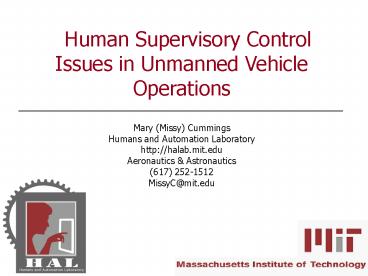- PowerPoint PPT Presentation
Title:
Description:
... NCW) Heuristics good & bad Biases Confirmation Recency Automation Distributed Decision-making & Team Coordination The move from hierarchical, ... – PowerPoint PPT presentation
Number of Views:23
Avg rating:3.0/5.0
Title:
1
Human Supervisory Control Issues in Unmanned
Vehicle Operations Mary (Missy) Cummings Humans
and Automation Laboratory http//halab.mit.edu Aer
onautics Astronautics (617) 252-1512 MissyC_at_mit.
edu
2
Humans Automation Lab
3
HAL Director
- Former U.S. Navy officer and pilot
- Systems engineer with a cognitive focus
- Research Interests Human supervisory control,
decision support design, human interaction with
autonomous systems, design of experiments
technology development, social impact of
technology
4
Human Supervisory Control
Actuators
Controls
Human Operator (Supervisor)
Displays
Sensors
- Humans on the loop vs. in the loop
- Supporting knowledge-based versus skill-based
tasks - Network-centric operations cognitive
saturation
5
(No Transcript)
6
Ten Areas of Concern
- Information overload
- Attention allocation
- Appropriate levels of automation
- Adaptive automation
- Decision biases
- Distributed decision-making through team
coordination - Complexity
- Supervisory monitoring of operators
- Trust and reliability
- Accountability
7
Information Overload
8
Attention Allocation
- Multiple HSC tasks Divided attention problem
- Information uncertainties time latencies
- Preview times stopping rules
- Primary task disruption by secondary task
- Chat
9
Appropriate Levels of Automation
Level Automation Description
1 The computer offers no assistance human must take all decision and actions.
2 The computer offers a complete set of decision/action alternatives, or
3 narrows the selection down to a few, or
4 suggests one alternative, and
5 executes that suggestion if the human approves, or
6 allows the human a restricted time to veto before automatic execution, or
7 executes automatically, then necessarily informs humans, and
8 informs the human only if asked, or
9 informs the human only if it, the computer, decides to.
10 The computer decides everything and acts autonomously, ignoring the human.
10
Adaptive Automation
- Dynamic role allocation
- Mixed initiatives
- A problem of intent
- Cueing mechanisms
- Psychophysiological
- Decision theoretic
- Performance-based
11
Decision Biases
- Naturalistic Decision Making
- Dynamic ill-structured problems with shifting
goals (i.e., NCW) - Heuristics good bad
- Biases
- Confirmation
- Recency
- Automation
12
Distributed Decision-making Team Coordination
- The move from hierarchical, centralized to
decentralized control - Team mental models shared situation awareness
(SA) - Decision support
- Automated agents as team members
- Not just an issue for human teams
- Swarming UAVs
13
Complexity
14
Supervisory Monitoring
- Nested supervisory control
- Two basic issues Recognizing intervening
- Interventions
- Redistribute workload
- Adding team members (both human computer)
- Modify mission objectives
15
Trust Reliability
16
Accountability
17
The Future of UVs and NCO
- We cant do it without automation intelligent
autonomy - Bounded Collaboration
- Human-centered design vs. mission-centered design
- Unmanned systems do not really exist
- The systems engineering process must consider
humans early - Robust systems are needed for both human and
automation brittleness considerations

